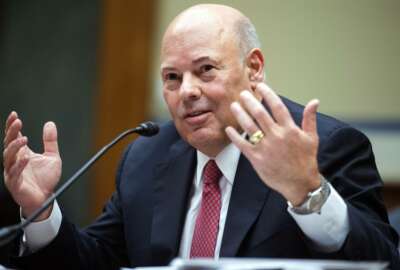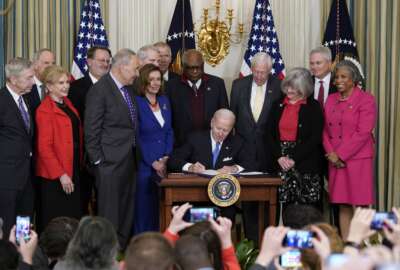

Perspectives are mixed on whether the Postal Service Reform Act has put USPS on a path to leave its long-term financial woes in the past.
The Postal Service, after trying for more than a decade, finally convinced Congress last year to pass reform legislation, in the hopes of improving the agency’s long-term financial health.
After USPS made it through the worst of the COVID-19 pandemic — which brought the agency to the brink of running out of cash — and released a long-awaited 10-year plan detailing ways it could cut costs and generate more revenue, lawmakers agreed on legislation that would save the agency save billions of dollars.
The Postal Service Reform Act, signed into law by President Joe Biden in April 2022, eliminated a 2006 mandate from Congress to pre-fund retiree health benefits, a requirement that, Biden said, “stretched the Postal Service’s finances almost to the breaking point, with real consequences.”
Lawmakers expected the legislation would save USPS a total of $107 billion — with more than half of those savings going into effect immediately, by forgiving $57 billion in deferred payments to its retiree health benefits fund.
Postmaster General Louis DeJoy made the bill the only legislative ask in his 10-year reform plan, which is now two years old. Under that plan, USPS expected to “break-even” as soon as this fiscal year— the first step in fully reversing a decade of net losses by 2030.
But USPS, a year after that legislation went into effect, is falling behind on its financial goals, and isn’t yet on track to reach that break-even point.
USPS recently reported that, as of February 2023, it has seen a $2.19 billion loss for the fiscal year so far — nearly double the year-to-date loss it planned for.
The agency is also seeing a significant decline in mail and package volume. According to its February 2023 report, first-class mail volume is down 9.4% compared to February 2022. Package volume is down 17.5% for the same period.
Meanwhile, the agency is settling into a familiar routine of biannual rate increases for its monopoly mail products, yet continues to receive complaints from Congress about constituents reporting regional mail and package delays.
The agency announced Monday that it plans to raise rates again. The proposed rates would go into effect on July 9, and would raise the price of a first-class stamp to 66 cents.
USPS said operating expenses fueled by inflation continue to rise, and that the agency is making up for years of operating under a “defective pricing model.”
USPS raised the price of a first-class stamp to 63 cents in January, after raising it from 58 cents to 60 cents in July 2022.
Mike Plunkett, former USPS manager for pricing strategy and innovation and manager of retail alliances, now president of the Association for Postal Commerce, said the rate hikes have been “frustrating, but not surprising.”
“We’re seeing [volume] declines that have happened twice before — once for the Great Recession, and once for the COVID pandemic,” Plunkett said. “We don’t have any comparable events going on right now.”
Paul Steidler, a senior fellow at the Lexington Institute, said the agency’s long-term financial health has “generally not” improved a year after the Postal Service Reform Act became law.
“They’ve got plummeting mail volume. Their losses are far ahead of projections,” Steidler said. “The Postal Service, like everybody else, has had to deal with inflation and they’ve had to deal with the tight labor market and the demand for workers out there.”
American Postal Workers Union President Mark Dimonstein said the union is concerned by the frequency of the rate increases, but said higher postal rates reflect the fact that USPS is almost entirely self-funded through its own revenue.
“There’s certainly a balance. We’re not economists, we understand inflation’s far too high for working people, but it also affects the Post Office. They are going to have to raise some rates, in order to be able to carry out its mission. But we don’t want them raised so far, that they’re hurting customers,” Dimonstein said.
Edmund Carley, national president of the United Postmasters and Managers of America, said USPS is raising rates to cover its increasing costs.
“All we’re really doing is right-sizing the pricing to actually do what the law says, which is we’re going to charge you what it costs us to do the work,” Carley said.
DeJoy said last May that USPS will keep raising mail rates at an “uncomfortable rate,” until it reaches a point where the agency is on track to be self-sustaining in the long term.
However, Steidler said that message is telling customers to take their business elsewhere.
“What it does is it signals to mailers, or those making marketing decisions … that mail is just going to be inordinately much more expensive going forward here … There doesn’t seem to be an understanding by the Postal Service about the effect that has had on mail volume,” Steidler said.
Lawmakers, USPS management, postal unions and experts in the postal community generally agree the Postal Service is in better shape now than it was a year ago, but perspectives are mixed on whether the legislation has put USPS on a path to leave its long-term financial woes in the past.
Peter Pastre, USPS vice president of government relations and public policy, told Federal News Network in a statement that implementation of the Postal Service Reform Act is “on target and emblematic of what strong bipartisanship legislation can achieve.”
“The act resulted in a stronger financial position for the Postal Service, allowing us to continue to invest in our network, vehicles, facilities, and employees,” Pastre said.
Pastre said USPS plans to launch a service performance dashboard required under the legislation in mid-May, and that “all the other governance and oversight reforms are operating as intended.”
Meanwhile, USPS has kept Congress updated on progress made with its 10-year Delivering for America plan.
“We are optimistic about the self-help operational progress contained in Delivering for America, and grateful for the financial reforms contained in PSRA,” Pastre said.
Steidler, however, said the Postal Service Reform Act offered financial relief to USPS without addressing “some of the tougher, and frankly more important issues,” including codifying a higher standard of delivery service or giving its regulator, the Postal Regulatory Commission, more enforcement power.
“I don’t think you can pop open the champagne at this point and say, ‘Yeah, a year after the legislation was enacted, everything is all well and good for the Postal Service,’” Steidler said. “The initial indication is things are probably not as good as most people would have projected a year ago.”
Meanwhile, Plunkett said the Postal Service Reform Act “didn’t really reform anything.”
“It moved some liabilities, and eliminated some requirements that the Postal Service fund its future obligations, but it didn’t change anything. It didn’t modify regulations, it didn’t change the structure of the Postal Service,” he said.
Among the key pillars of the Postal Service Reform Act, the legislation eliminated a central element of the 2006 Postal Accountability and Enhancement Act (PAEA).
PAEA required USPS to prefund health benefits for its retirees well into the future, rather than allow the agency to remain on a pay-as-you-go system.
The elimination of that prefunding mandate resulted in USPS reporting a $56 billion net income for fiscal 2022 — ending a 15-year streak of annual net losses. But given more recent financial reports, USPS is on track to end fiscal 2023 in the red.
Former Rep. John McHugh (R-N.Y.), a cosponsor of the 2006 PAEA legislation, now president of the Package Coalition, said the prefunding mandate ended up hurting USPS — especially after first-mail volume fell precipitously following the 2008 recession.
“It’s clear, historically, looking back through those years that it was an unreasonable burden. And the Postal Service, I think, deserved that relief,” McHugh said.
McHugh said the Postal Service Reform Act succeed where other similar bills failed, because of the heroic role USPS held in the early stages of the COVID-19 pandemic, when the agency became a vital lifeline for households under lockdown mandates to send and receive essential goods.
Congressional leadership, he added, also recognized the need to make the financial stability of USPS a priority, after USPS leadership in 2020 warned the pandemic accelerated a timeline of when it would run out of cash to operate.
“Passing a bill — any bill — is an enormously complex affair, as I learned firsthand. But I think those two — environment and leadership — the way the leadership worked amongst themselves prior to any kind of bill hitting the floor, was key to that success,” McHugh said.
DeJoy played an active role in pitching the legislation to Republican lawmakers skeptical of earlier USPS reform efforts, but ultimately won them over by providing a 10-year reform plan of the agency planned to dig out a financial hole.
“That’s why we got postal reform — he had a plan. Before, there was never a plan,” Carley said. “Postmasters general, in the past, have said, ‘Congress, do something and we’ll give you a plan.’ And Congress never did anything. So they never provided a plan.”
House Oversight and Accountability Chairman James Comer (R-Ky.), a champion of the Postal Service Reform Act in the House, said the legislation cleared a path for USPS “to regain financial viability while providing the high quality of service Americans expect and deserve.”
Comer also praised DeJoy for charting a path forward for USPS, and said the committee would “strike an appropriate balance between oversight and giving Mr. DeJoy room to make the changes he thinks are in the long-term interests of the Postal Service.”
“Postmaster DeJoy is an experienced and strong leader. We are only in year two of his ten-year reform plan, and he faces a monumental task in turning around a struggling agency, particularly during a period of high inflation,” Comer said.
Ranking Member of the Cybersecurity, IT and Government Innovation Subcommittee Gerry Connolly (D-Va.), a co-author of the Postal Service Reform Act, said the legislation “places USPS back on the path to financial solvency,” and guarantees six-day mail delivery.
“I look forward to continuing efforts to improve the USPS, so it remains a robust and competitive entity,” Connolly said.
Government Operations Subcommittee Chairman Jody Hice (R-Ga.) said in a hearing last month that the subcommittee would have DeJoy testify “very soon, probably, for a subcommittee hearing, just to give us a report” on USPS operations.
“We’ve got a lot invested in this. We want to see some performance from him as well. Performance would, in my opinion, indicate cutting the losses and improving postal performance,” Hice said.
Regardless of what the Postal Service Reform Act means for USPS’s bottom line, Carley said the agency’s next steps now rest entirely on DeJoy and the agency’s other executives.
“The ball is now firmly in his court. It’s time for him to put up or shut up,” Carley said.
The postal community is counting on USPS to use its upcoming performance dashboard next month to begin addressing degradations in delivery service that have persisted in recent years.
Dimonstein said the union welcomes input from USPS on ways to improve service, but said those ideas have not been put into practice.
“There’s still a lot of work that needs to be done to improve service to the people of the country, the kind of service that they promised under the law. That’s not there right now,” Dimondstein said.
Steidler said the dashboard would help USPS identify and address regional problems with on-time mail delivery.
“I’m not saying the dashboard that they should have [up] at this point should have the most sophisticated bells and whistles — the utterly best dashboard website any government agency in the world has ever had — but there really should be something up,” Steidler said.
USPS is no longer experiencing systemwide delays that made service inconsistent for much of the country across 2020 and early 2021. However, Steidler pointed to many letters from House and Senate lawmakers that USPS is still encountering regional challenges with on-time delivery.
“It provides some fire underneath the Postal Service for things to be improved,” Steidler said. “It’s of far less consequence if, on average, something takes a day or two more to come in. but when you’re not getting anything for like a couple of weeks, and you’ve got a business or you’re expecting important stuff, that’s a huge deal.”
Sen. Jerry Moran (R-Kan.) and Rep. Sharice Davids (R-Kan.) raised concerns to DeJoy in an April 6 letter about constituents reporting missing mail, delayed delivery and “extended periods with no delivery service at all.”
The lawmakers said some constituents reported only getting mail three days a week, and that nearby post offices reported being “understaffed and unable to process mail at an efficient capacity.”
Moran and Davids said they were proud to vote for the Postal Service Reform Act a year ago to resolve the agency’s “deepening financial trouble,” but said USPS has not yet upheld its part of the bargain.
“It is unacceptable that implementation of certain provisions, including the six-day-a-week delivery service, is not being accomplished by USPS,” they wrote.
USPS recently announced Stephen Dearing will serve on an acting basis as the agency’s new chief data and analytics officer position “responsible for managing enterprise data sources and coordinating analytics throughout the organization.”
Once launched, the USPS dashboard is expected to complement similar tools developed by the USPS inspector general’s office and the Postal Regulatory Commission.
Postal experts point to ongoing USPS staffing problems as a root cause behind service delays.
Dimondstein said that in some areas of the country, USPS is having trouble finding candidates to hire, while in other cases, the hiring process is too slow and candidates find work elsewhere.
“The main problem is once people are hired, there’s a tremendously high level of turnover, so retention is a huge problem,” Dimondstein said.
To add to those retention problems, Dimonstein said new USPS employees are often hired into non-career positions at a lower rate of pay than career positions.
Ivan Butts, president of the National Association of Postal Supervisors, said the current USPS environment gives new hires little incentive to stay for the long term.
“When the Post Office decided that it no longer wanted to be the middle-class employer of careers — that attracted our veterans and more focused individuals to come on board and work — and go through this supplemental, non-career workforce, it changed the caliber of employee that you recruit and you receive,” Butts said.
Carley said postmasters in some parts of the country are still sometimes out delivering mail on days when there aren’t enough employees to cover every route.
As a major part of its 10-year reform plan, USPS is embarking on $40 billion in long-deferred capital investments. Those include its next-generation delivery fleet, new mail and package sortation equipment, and Sorting and Delivery Centers (S&DC).
“The Postal Service thrives when there’s stability. The problem with the Postal Service over the last 15 years was we really didn’t know how we were going to make it,” Carley said. “And so, we ignored a lot of problems we had, because we were too busy just doing triage day-to-day. I believe that will stop. That’s already stopped in some areas, and will stop in other areas.”
USPS last fall identified more than 200 post offices and other facilities that would be consolidated into 21 S&DCs, large facilities that accommodate mail processing and mail delivery operations all under one roof.
The restructuring is generally expected to not affect the retail functions of “spoke” post offices, including PO box service.
DeJoy, speaking at the American Enterprise Institute in July 2022, said he plans to consolidate 500 facilities USPS processes and moves mail through down to about 65 or 75 regional hubs.
Dimondstein said APWU remains unsure if the S&DC consolidation effort is going to improve or diminish USPS service.
“Our feelings are mixed,” he said. “If they’re going to diminish service, then we’re going to unite with the people of the country to say no. If it’s going to improve service — even if it’s going to be a transition that’s going to be challenging — then we have a very different view of it.”
Dimonstein said the union opposes any effort by USPS to reduce hours or eliminate the retail operations at those post offices.
“We have deep concerns there. We’re trying to get commitments, but if we can’t then we’re going to be calling upon the people of the country to defend their right to rebuild services in their communities,” he said.
The Postal Service Reform Act also gives USPS additional authority to serve as a one-stop shop for other federal state and local government services.
Dimonstein said the law opens up an opportunity for USPS to bring in additional revenue from state and local government services — as well as improve access to those services in rural areas.
“We know in a lot of parts of the country, people don’t have easy access to those state and local government services,” Dimonstein said.
Steidler said the successful rollout of CovidTests.gov and USPS delivering hundreds of millions of free rapid tests demonstrates how the agency can enter into new lines of business in partnership with other agencies.
“There are opportunities with regard to state and local governments, and those ought to be pursued very aggressively, especially in light of the recent fall in mail volume. There really ought to be a sense of urgency about that,” Steidler said.
Copyright © 2024 Federal News Network. All rights reserved. This website is not intended for users located within the European Economic Area.
Jory Heckman is a reporter at Federal News Network covering U.S. Postal Service, IRS, big data and technology issues.
Follow @jheckmanWFED



